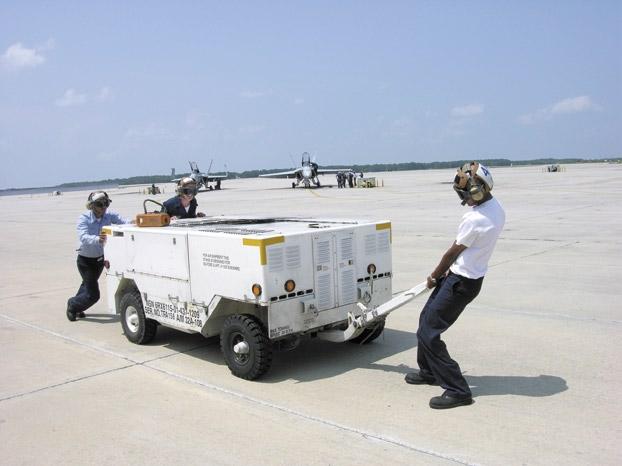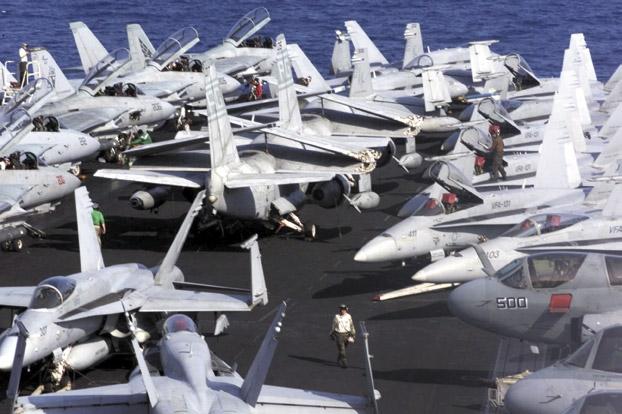
4 minute read
Tango With a Power Cart
Tango With
By AEAN Christopher Pike
Advertisement
a Power Cart
It all started out as a normal night-check shift in the AE shop at VFA-86. I was on the way out to the flight line with an AE3 CDI to rig the electronic drive units (EDUs) for an FA-18 wing-fold system. In order to rig the EDUs, I needed an NC-10 mobile electrical-power cart to put power on the jet, but the cart was in the hangar. Before this job was done, I would wish I had stayed there.
The squadron’s standard operating procedure (SOP) states that support equipment is not moved in the hangar with a tow tractor. Because of the SOP, we usually don’t bring the NC-10 into the hangar, but it recently had been used on a jet where no power cord was available. In order to get it out to the flight line, we had to roll the NC-10 outside the hangar and hook it up to a tractor. We then could pull it to the jet.
The NC-10 was on the other end of the hangar, and, because it weighs more than 6,000 pounds, I rounded up a few shipmates to help move it. Although the NC-10 is on wheels, moving it is much like pushing a car around in neutral. Unlike a car, the NC-10 doesn’t have a steering wheel, so the tow bar in front needs to be turned to steer the cart.
The move crew pushed the cart while I manned the tow bar—since it is easier to pull it while steering. I was walking backward as we crossed the hangar, approaching the starboard side of a parked jet. Although I couldn’t see where I was going, the move crew was looking ahead and telling me which way to steer.
All of a sudden, I heard the AE3 CDI yell, “Watch your head!”
It happened just as I was about to run into a control surface of the jet behind me. I tried stopping the power cart, but, as I planted my feet, I slipped on JP-5 that had spilled on the deck. As I fell down, the bar came down on my hand, cutting open my pinky finger. We applied pressure to the wound, stopping the blood. I jumped into a car, and a team member drove me to the naval hospital.
The cut required seven stitches to close, and I spent six days SIQ and light duty for another 10. What
Power Cart
seemed like a simple maintenance evolution cost me officer to be present and to serve as a safety observer. two weeks away from the job and a permanent scar on We should have applied this requirement. It would my hand. have ensured we were on the right path and could have
A little time-critical ORM might have prevented helped us to avoid what turned out to be a dangerous this mishap. Two primary hazards existed: running into situation. a jet or some other object while moving the NC-10 out When we discuss ORM, it normally is in a Powerof the hangar, possibly damaging both objects; and rollPoint presentation about the five steps and is preing it over a slick surface where one of the move crew sented in some detailed fashion. In reality, we practice could slip. time-critical ORM every day. We do it when following
We normally move the cart slowly, so a mistake checklists, SOPs, and using common sense in dangershould cause only minor damage. The job only posed ous environments. a minor risk, and fixing the jet was a squadron priorThis is a simple story, but it illustrates the impority. We did implement some controls (e.g. the team tance of quickly using the five-step process on any job. pushing while I pulled and steered), but we could have A quick review of the situation would have taken only a implemented just a few more to mitigate the hazards. couple minutes and might have prevented the scar on I could and should have told everyone the route we my hand. would take through the hangar and should have quickly Airman Pike works in the AE shop at VFA-86. checked the deck for slick spots. With those controls, everyone would have been prepared for the route, and no one would have been surprised at seeing the control surface near our path of travel. We also would have avoided the JP-5 on the deck. The final step in ORM is supervision. Whenever we tow a jet, VFA-86 SOP requires a first class petty Good story from a young Sailor who learned the hard way. One amazing part of the story easily can be missed. The squadron had a standard operating procedure that required senior supervision for aircraft moves. Maybe that policy should include SE moves in confined spaces.— Ed. Navy photo by PH2 LeLand Comer
Moving any cart around the deck potentially is hazardous.











